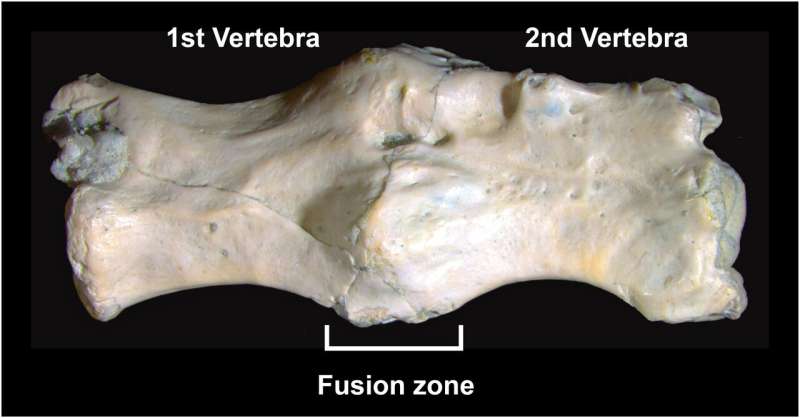Permian lizard-like animal suffered from a bone condition similar to Paget's disease

A lizard-like animal that lived 289 million years ago suffered from a bone condition similar to Paget's disease, according to a study published August 7, 2019 in the open-access journal PLOS ONE by Yara Haridy of the Museum für Naturkunde in Berlin and colleagues. This is the most ancient known case of such a disease.
The animal in question belonged to an extinct group of lizard-like creatures called varanopids, relatives of the earliest ancestors of mammals or reptiles. The authors identified the disease in an isolated pair of tail vertebrae discovered in an Early Permian cave at Richards Spur, Oklahoma. Micro-CT scanning allowed examination of both the external and internal structure of the elements, revealing that in some places the bone had been thinned by abnormally high levels of reabsorption, while in other areas excessive bone growth had resulted in abnormal bone thickening and the ultimate fusion of the two vertebrae.
According to the researchers, this condition is most similar to Paget's disease, a bone metabolic disorder marked by a breakdown in communication between bone building cells and bone destroying cells. Paget's disease is commonly seen today in the hips and vertebrae of humans and has been diagnosed in other living mammals and reptiles as well as one Early Jurassic dinosaur fossil. The disease has been linked to both genetic and viral factors, though its precise cause remains controversial.
With only two vertebrae preserved, it is impossible to say how widespread the disease was in this animal's body. If it was restricted to the tail, the animal may only have suffered minor pain and stiffness. This discovery marks the oldest known occurrence of a Paget-like disease and suggests that susceptibility to such disorders was already present in our early Permian cousins.
Haridy adds: "Paleopathology is the study of ancient diseases, here we scanned a pair of fused tail bones from a permian (280 million years ago) Varanopid (a superficially-lizard like animal), what we found was evidence of a bone disease similar to modern day Paget's disease. This enigmatic disease is still not well understood in humans, however finding something similar in an ancient animal likely links it to something deep in our bone biology. This study is a great example of how when palaeontologists have well preserved fossils we can tell a lot more than just what animals were present, we can explore their biology, physiology and even what diseases ailed them!"
More information: Haridy Y, Witzmann F, Asbach P, Reisz RR (2019) Permian metabolic bone disease revealed by microCT: Paget's disease-like pathology in vertebrae of an early amniote. PLoS ONE 14(8): e0219662. doi.org/10.1371/journal.pone.0219662
Journal information: PLoS ONE
Provided by Public Library of Science



















